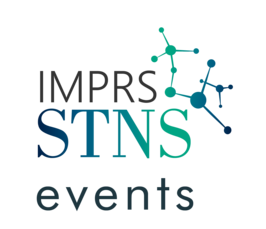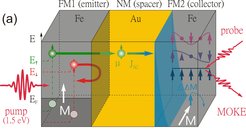Optical generation of femtosecond spin-current pulses and terahertz standing spin waves in metallic multilayers
Tutorial
- Datum: 14.08.2019
- Uhrzeit: 16:00
- Vortragende(r): Dr. Alexey Melnikov
- Martin Luther University Halle-Wittenberg
- Ort: Max-Planck-Institut für Mikrostrukturphysik, Weinberg 2, 06120 Halle (Saale)
- Raum: Lecture Hall, B.1.11
- Gastgeber: IMPRS-STNS

The key challenge in a rapidly emerging field of modern spintronics consists in the push from the GHz to THz domain. In particular, it requires the development of techniques for the generation of femtosecond spin current (SC) pulses. With the help of magneto- induced second harmonic generation (mSHG) in the back pump-front probe scheme, we have demonstrated long-range (ballistic) spin transport on a femtosecond timescale upon laser excitation of the Fe film in epitaxial Fe/Au bi-layers [1]. Later on, in Fe/Au/Fe tri- layers, this technique allowed us to demonstrate 250 fs-short SC pulses and attribute their origin to the non-thermal spin-dependent Seebeck effect at ferromagnet/normal metal interfaces where the optically excited Fe film serves as a SC emitter [2]. With the time- resolved magneto-optical Kerr effect (MOKE), we have demonstrated the excitation of sub-THz perpendicular standing spin waves (PSSW) in the opposite Fe layer (collector) by interface-confined spin transfer torque (STT) exerted by these SC pulses [3].

Using both mSHG and MOKE detection in similar Fe/Au and Fe/Au/Fe structures with continuously varying thickness of the Fe emitter, we optimize the excitation of THz PSSWs and obtain new insights into under- lying electron and spin dynamics. In parti- cular, from the SC generation efficiency dependence on the emitter thickness peak- ing at ~6 nm, we estimate the escape depth of hot majority electrons in Fe of ~2 nm.
To tune the PSSW frequencies, we fabricated an epitaxial Fe/Au/Fe structure with continuously varying Fe collector thickness from 1 to 17 nm. We demonstrate efficient STT-driven excitation of PSSWs with frequencies up to 2 THz corresponding to spin- wavelengths of 2 nm. Signatures of the higher-order PSSWs with frequencies up to 5 THz are also observed. We analyze the PSSW dispersion, damping, and amplitudes in the time domain as well as their dependence on the collector thickness and discuss new in- sights into the STT-induced THz spin dynamics along with perspectives for experiments.
[1] A. Melnikov, I. Razdolski, T. Wehling, E. Papaioannou, V. Roddatis, P. Fumagalli, O.A. Aktsipetrov, A. Lichtenstein, and U. Bovensiepen, Phys. Rev. Lett. 107, 076601 (2011).
[2] A. Alekhin, I. Razdolski, N. Ilin, J.P. Meyburg, D. Diesing, V. Roddatis, I. Rungger, M. Stamenova, S. Sanvito, U. Bovensiepen, and A. Melnikov, Phys. Rev. Lett. 119, 017202 (2017).
[3] I. Razdolski, A. Alekhin, N. Ilin, J.P. Meyburg, V. Roddatis, D. Diesing, U. Bovensiepen, and A. Melnikov, Nature Commun. 8, 15007 (2017).
